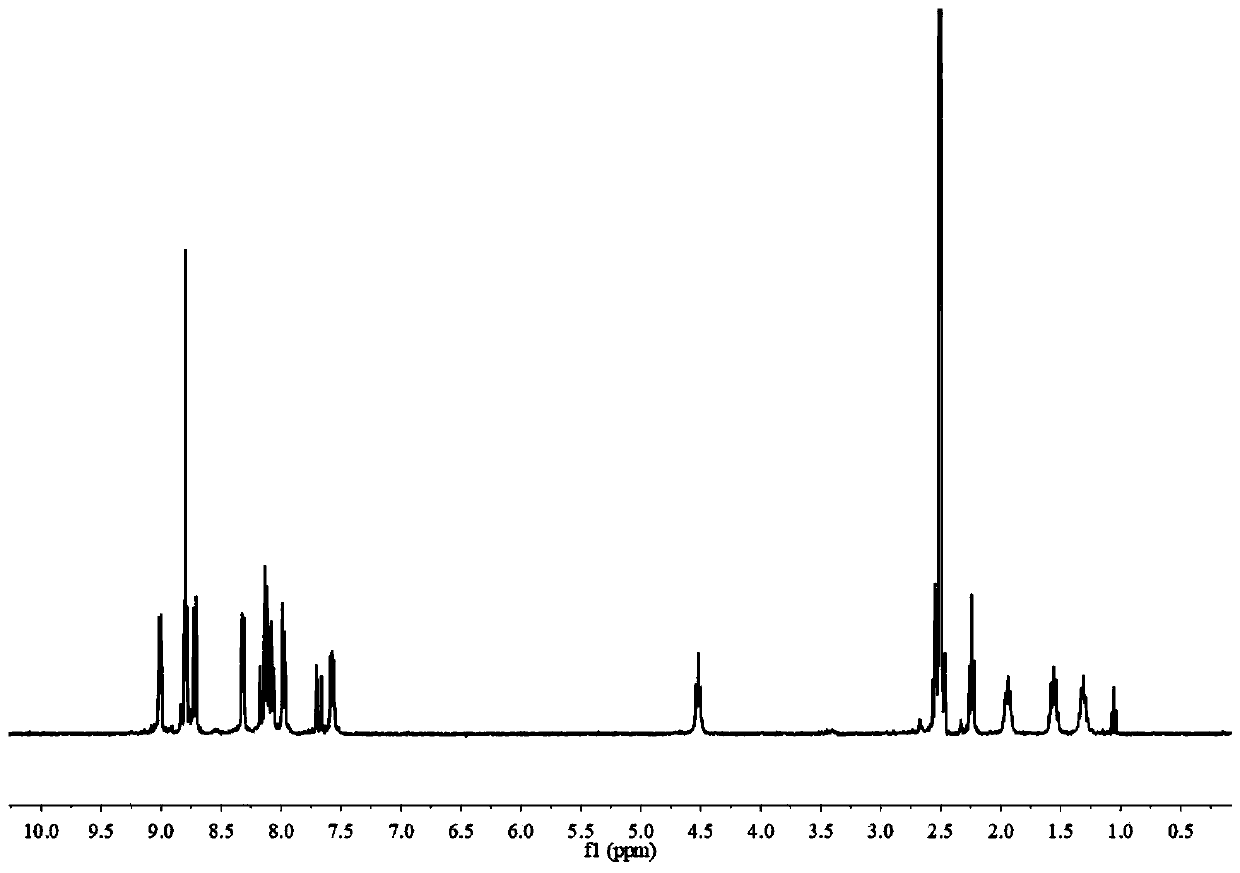Fluorescent probe for identifying mercury ions and preparation and identification method thereof
A fluorescent probe and identification method technology, applied in chemical instruments and methods, fluorescence/phosphorescence, luminescent materials, etc., can solve the problems of high detection cost, time-consuming, complex sample processing, etc., and achieve the effect of simple operation and low detection cost
- Summary
- Abstract
- Description
- Claims
- Application Information
AI Technical Summary
Problems solved by technology
Method used
Image
Examples
Embodiment 1
[0041] Embodiment 1: A kind of fluorescent probe that recognizes mercury ion, the molecular formula of probe is: C 34 h 31 BrN 4 o 2 , the structural formula of the probe is attached figure 1 Shown; NMR spectrum as attached figure 2 shown.
Embodiment 2
[0042] Embodiment 2: a kind of preparation method of the probe described in embodiment 1, the steps are as follows:
[0043] (1) Add 1g of 4-bromobenzaldehyde in 15mL of ethanol to obtain A;
[0044] (2) Add 1.21g of 2-acetylpyridine, 0.9g of potassium hydroxide and 15mL of ammonia water to 20mL of ethanol to obtain the B substance;
[0045] (3) Mix substance A and substance B, stir at 2°C for 1 hour, and reflux at 80°C for 20 hours, then cool to room temperature and stir for 45 minutes, filter the precipitate, and recrystallize in acetic acid to obtain substance C;
[0046] (4) Mix 300mg 4-pyridineethylene, 60mg palladium acetate, 200mg triphenylphosphine and 20cm 3 Triethylamine, seal the mixture under N 2 In a high-pressure reaction flask under atmosphere, react at 110°C for 70 h, dissolve the product in chloroform, wash the organic phase with distilled water for 3 times, then wash the organic phase with saturated saline for 3 times, dry with anhydrous magnesium sulfate f...
Embodiment 3
[0048] Embodiment 3: a kind of preparation method of the probe described in embodiment 1, the steps are as follows:
[0049] (1) Add 0.5g of 4-bromobenzaldehyde in 15mL of ethanol to obtain A;
[0050] (2) Add 1g of 2-acetylpyridine, 0.5g of potassium hydroxide and 10mL of ammonia water to 20mL of ethanol to obtain material B;
[0051] (3) Mix substance A and substance B, stir at 0°C for 3 hours, and reflux at 70°C for 30 hours, then cool to room temperature and stir for 30 minutes, filter the precipitate, and recrystallize in acetic acid to obtain substance C;
[0052] (4) Mix 250mg 4-pyridineethylene, 50mg palladium acetate, 150mg triphenylphosphine and 15cm 3 Triethylamine, seal the mixture under N 2 In a high-pressure reaction flask under atmosphere, react at 100°C for 65 h, dissolve the product in chloroform, wash the organic phase twice with distilled water, then wash the organic phase twice with saturated brine, dry over anhydrous magnesium sulfate for 0.5 h, and spin...
PUM
| Property | Measurement | Unit |
|---|---|---|
| wavelength | aaaaa | aaaaa |
Abstract
Description
Claims
Application Information
 Login to View More
Login to View More - R&D
- Intellectual Property
- Life Sciences
- Materials
- Tech Scout
- Unparalleled Data Quality
- Higher Quality Content
- 60% Fewer Hallucinations
Browse by: Latest US Patents, China's latest patents, Technical Efficacy Thesaurus, Application Domain, Technology Topic, Popular Technical Reports.
© 2025 PatSnap. All rights reserved.Legal|Privacy policy|Modern Slavery Act Transparency Statement|Sitemap|About US| Contact US: help@patsnap.com



